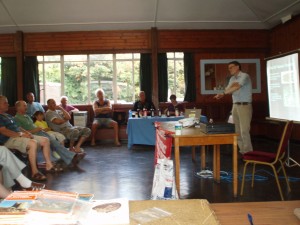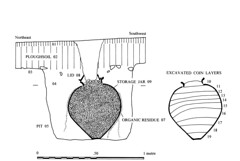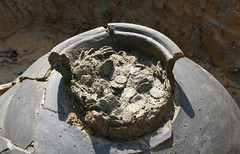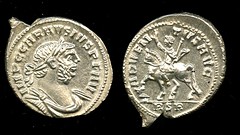July 13th, 2010 by Anni Byard
Welcome to the new PAS blog for Oxfordshire and West Berks. Every month I receive lots of finds submitted for recording by independent detectorists, club members and non-detecting members of the public. Finds range from Neolithic polished axes (a personal favourite of mine!) to Roman ‘grots’ , from Saxon brooches to Post-medieval hook-clasps and everything in between. I’d like to use this blog to showcase some of my favourite finds from Oxon & W.Berks, as well as keep you up to date with other discoveries and stories from the area, including progress on the West Hanney Saxon Burial discovered during the Weekend Wanderers Summer Rally 2009. In an ideal world I’d upload my favourite finds on a weekly basis, but we all know just how busy FLO’s are, so it will probably end up being a find of the month blog!
This post is just a short overview of how you can get our data onto your website without being uber-geeky and knowing how to play with our Applications Programming Interface (API – more on this over the next month or so.) The Scheme’s website can now serve up various different flavours of content by means of context switching. You can now get:
- RSS
- ATOM
- XML (finds lists and searches are returned in MIDAS format, other pages just plain XML responses)
- JSON
- KML
- CSV
To find out what versions of the content you can retrieve for a page is pretty simple. If you scroll towards the foot of any page on our website, look for the text:
This page is available in: {contexts available} representations.
This makes use of the Zend Framework context switch parameter -format. So any URL that has an alternative representation just needs appending format/{context}. So for example, you want to view all finds for Essex in ATOM format you would call this url:
http://www.finds.org.uk/database/search/results/county/ESSEX/format/atom
You can now use this output within your own site using simple software tools such as widgets, simplepie etc. However, what is probably of more interest to many people is getting a map of objects found locally to them. So for example, you run a parish council and you want all objects found in the district. Let’s try my home district of South Cambridgeshire. If you go to our advanced search facility and scroll to the bottom and choose county as Cambridgeshire and district as South Cambridgeshire, then submit the form and wait a second for the search to complete.
Now that the results are there, look at the page foot for the representations available and you’ll see the letters KML. If you click on this, you can now get data in the format that can be used in many online mapping programmes and Google Earth. So if you want to see this on the map, copy the URL generated; in this case:
http://www.finds.org.uk/database/search/results/county/CAMBRIDGESHIRE/district/SOUTH+CAMBRIDGESHIRE/format/kml
Now head over to http://maps.google.com.
In the search bar, paste the URL that you copied and press search.

The map should now change to show pins for degraded findspot locations. These pins are only provided when the ‘to be known as’ field has not been filled in and the actual points are taken from the 1km grid reference (4 figure). So the map should now render like the below image:

Now you have generated this map, you can grab either the link for the map and send directly to some one, or you can grab the HTML code to embed the map into a webpage. Look in the top corner of the map for the control labelled embed and click this; you then get the layer appearing which looks like the image below:

As this post deals with embedding the map on your own webpage, it is assumed that you can enter raw HTML directly. Copy the text which is contained in the box labelled “Paste HTML to embed in website”. This looks like:
<iframe width="425" height="350" frameborder="0" scrolling="no" marginheight="0" marginwidth="0"
src="http://maps.google.com/maps?f=q&source=s\_q&hl=en&geocode=&q=http:%2F%2Fwww.finds.org.uk%2Fdatabase%2Fsearch%2Fresults%2Fcounty%2FCAMBRIDGESHIRE%2Fdistrict%2FSOUTH%2BCAMBRIDGESHIRE%2Fformat%2Fkml&sll=37.0625,-95.677068&sspn=47.885545,114.169922&IE\=UTF8&ll=52.257917,-0.000189&spn=0.72983,0.782087&iwloc=lyrftr:kml:cF4oaez0SXhtHIuPUpXMoJUR9uPk2SiORITteHHHGjS0fvow5su0kSjIVdHy4TwDOfCcxM4bseHHEGTe2fPgy5si2VKsJEzIMAg,gf42aba810981b24d,52.065156,0.171661,0,-32&output=embed"></iframe>
<br /><small>
<a href="http://maps.google.com/maps?f=q&source=embed&hl=en&geocode=&q=http:%2F%2Fwww.finds.org.uk%2Fdatabase%2Fsearch%2Fresults%2Fcounty%2FCAMBRIDGESHIRE%2Fdistrict%2FSOUTH%2BCAMBRIDGESHIRE%2Fformat%2Fkml&sll=37.0625,-95.677068&sspn=47.885545,114.169922&IE\=UTF8&ll=52.257917,-0.000189&spn=0.72983,0.782087&iwloc=lyrftr:kml:cF4oaez0SXhtHIuPUpXMoJUR9uPk2SiORITteHHHGjS0fvow5su0kSjIVdHy4TwDOfCcxM4bseHHEGTe2fPgy5si2VKsJEzIMAg,gf42aba810981b24d,52.065156,0.171661,0,-32" style="color:#0000FF;text-align:left">View Larger Map</a>
</small>
Then once you have pasted this code into your webpage, saved it and if you aren’t using a content management system, upload it to your website and then the map will be embedded as shown below:
[View Larger Map](http://maps.google.com/maps?f=q&source=embed&hl=en&geocode=&q=http:%2F%2Fwww.finds.org.uk%2Fdatabase%2Fsearch%2Fresults%2Fcounty%2FCAMBRIDGESHIRE%2Fdistrict%2FSOUTH%2BCAMBRIDGESHIRE%2Fformat%2Fkml&sll=37.0625,-95.677068&sspn=47.885545,114.169922&ie=UTF8&ll=52.257917,-0.000189&spn=0.72983,0.782087&iwloc=lyrftr:kml:cF4oaez0SXhtHIuPUpXMoJUR9uPk2SiORITteHHHGjS0fvow5su0kSjIVdHy4TwDOfCcxM4bseHHEGTe2fPgy5si2VKsJEzIMAg,gf42aba810981b24d,52.065156,0.171661,0,-32)
In the infowindow bubbles that come up when you click on a findspot location, you will see this text:
This findspot has been produced from the 4 figure reference. It is not the precise findspot.
As mentioned above, due to findspot security/ landowner privacy, and an agreement we have with the major body that gives us artefact spatial information, we cannot publish co-ordinates publicly at a precision greater than parish or 1km square (4 figure grid reference) and we also hold back from view finds that have had the “to be known as” field. Therefore, the map you get from this is not 100% accurate! This is not something we can change.
A couple of weeks ago, we sent a mailshot out to all MPs for England and Wales, detailing how they could get finds for their constituency onto their own webpages. This is done in exactly the same way as the above and constituency finds feeds can be obtained from the news section of the website under (and powered by YQL calls of the theyworkforyou API):
http://finds.org.uk/news/theyworkforyou/constituencies
Two examples with finds in their constituencies are the coalition leaders (the Roman coin hoard from Frome announced on the 8th July, had a colalition type coin inside). David Cameron’s constituency of Witney shows this map:
And Nick Clegg’s Sheffield Hallam constituency shows this map:
Once geoRSS is enabled and working properly, you can also do the above using any of the feeds for finds where the context switch called is ATOM. This will be done by the middle of next week, alongside ATOM paging.
Sam Moorhead, the PAS Roman coins finds advisor visited the Colchester Metal detecting club to talk to them about exciting Roman coin finds from the county.

To Sam, and other coin specialists, ‘exciting coins’ aren’t just the beautiful coins that are practically in mint condition. All those horrid looking grotty green discs that most people think are worthless are actually a fantastic source of information for archaeologists.
If you know where the coin was found, even the most corroded coin can help us to piece together the past. Coins that are mostly illegibly may still have traces of design which an expert like Sam can use to identify them; in the fourth century for example there are a restricted range of very standardised designs so it is often possible to identify them from even the smallest trace of a figure or object. Even with completely illegible coins the module (size, thickness and weight) can give a suggestion of whether they are 1st-2nd century coins or later, helping to give a general impression of the dating on the site. Even with this relatively loose dating, specialists can use the relative proportions of different coins from different Roman periods to begin to characterise sites. For example, very broadly speaking, rural sites generally produce much higher proportions of nummi than urban sites, which often produce more late third century radiates. Coins from certain periods tend to be found in a more worn condition than others so if we don’t examine all the coins, including the worn ones some periods may appear to be quiet when there was actually lots of activity.
Loads of Roman coins have been recorded throughout Essex check it out! http://www.finds.org.uk/database/search/map/objecttype/COIN/broadperiod/ROMAN/county/ESSEX
Tony Williams, Coroner for Somerset, will hold an inquest on Thursday 22nd July on one of the largest Roman coin hoards ever found in Britain, the Portable Antiquities Scheme funded by the Museums, Libraries and Archive Council and Somerset County Council has reported.
Dave Crisp, found the hoard of some 52,500 coins dating to the 3rd century AD, while metal-detecting near Frome, and reported the find to his local Finds Liaison Officer. Initially Mr Crisp found 21 coins, but when he came across a pot filled with more knew he needed archaeological help to excavate them.



Images can be downloaded from our flickr account at www.flickr.com/finds/
Anna Booth, Somerset County Council’s Finds Liaison Officer, said:
Because Mr Crisp resisted the temptation to dig up the coins it has allowed archaeologists from Somerset County Council to carefully excavate the pot and its contents, ensuring important evidence about the circumstances of its burial was preserved”.
Mr Crisp added :
I knew the find was important and I needed archaeological help, so I contacted my local Finds Liaison Officer. I have made many finds over the years, but this is my first coin hoard and it was a fascinating experience to take part in the excavation of it.”
Archaeologists believe the hoard, which sheds light on the economic crisis and coalition government in the 3rd century, will rewrite the history books. One of the most important aspects of the hoard is that it contains a large group of coins of Carausius, who ruled Britain independently from AD 286 to AD 293 and was the first Roman emperor to strike coins in Britain. The hoard contains over 760 of his coins, making it the largest group of his coins ever found. Amongst these coins are five rare examples of his silver denarii, the only coins of their type being struck anywhere in the Roman Empire at the time.
The coins span 40 years from AD 253 to 293 and the great majority are of the denomination known as ‘radiates’, made of debased silver or bronze.
The hoard is probably the equivalent of about four years’ pay for a legionary soldier.
Roger Bland, Head of Portable Antiquities and Treasure at the British Museum said:
This hoard, which is one of the largest ever found in Britain, has a huge amount to tell about the coinage and history of the period as we study over the next two years. The late 3rd century AD was a time when Britain suffered barbarian invasions, economic crises and civil wars. Roman rule was finally stabilised when the Emperor Diocletian formed a coalition with the Emperor Maximian, which lasted 20 years. This defeated the separatist régime which had been established in Britain by Carausius. This find presents us with an opportunity to put Carausius on the map. School children across the country have been studying Roman Britain for decades, but are never taught about Carausius – our lost British emperor”.
If the hoard is declared Treasure by the coroner, it is hoped it will be acquired by Somerset County Council’s Heritage Service. Stephen Minnitt, Head of Museums at Somerset County Council, said:
This is a find of great national importance and we are determined to raise the sum to acquire the hoard for public benefit. Hopefully it will be able to go on display in the new Museum of Somerset when it re-opens in 2011”.
Ed Vaizey, Minister for Culture at the Department for Culture, Media and Sport said:
Once again this demonstrates how important the Treasure Act and the Portable Antiquities Scheme are in helping to preserve our heritage. I congratulate Mr Crisp on his prompt reporting of his find and especially in allowing archaeologists to excavate the hoard. If the hoard is declared Treasure, Somerset County Council Heritage Service will have the opportunity to acquire it at its full market value, as determined by an independent committee and that reward is shared by Mr Crisp and the owner of the land where the find was made. That way everyone is a winner.”
In the meantime the coins have been washed and stabilised by a team of conservators at the British Museum, led by Pippa Pearce, and they are being studied by Roger Bland and the Portable Antiquities Scheme’s Roman coins specialist, Sam Moorhead. The British Museum is actively seeking funds to clean the coins fully: this will be a year’s work for one conservator.
A selection of coins from the hoard will be on display in Gallery 68 at the British Museum from Thursday 22nd July until mid-August. The Portable Antiquities Scheme is a voluntary scheme managed by the British Museum on behalf of the Museums Libraries and Archives Council (MLA) and is funded through Renaissance, a programme to transform England’s regional museums.
For further details, including a full account of the discovery, images of the excavation and of the coins and a video of the removal of the coins from the pot see: www.finds.org.uk/fromehoard
For further information please contact:
Rebecca Musto PR and Communications Officer on 01823 355585 or email rmusto@somerset.gov.uk.
Roger Bland, Head of Portable Antiquities & Treasure, British Museum, 0798 966 9414, rbland@thebritishmuseum.ac.uk or Sam Moorhead, National Finds Adviser, Portable Antiquities Scheme, 0770 4677443, smoorhead@thebritishmuseum.ac.uk
Olivia Rickman, Press Manager, British Museum, 020 7323 8583, orickman@thebritishmuseum.ac.uk
Notes
Upon discovering the hoard Dave Crisp contacted Katie Hinds, Finds Liaison Officer for Wiltshire. MS Hinds then contacted Anna Booth, Somerset Finds Liaison Officer, who, with Somerset County Council archaeologists, set about the delicate task of excavating the pot and its contents. The hoard was then taken to the British Museum, so that the coins could be cleaned and recorded. This work was done within two months and represented about 400 hours’ work for the conservator team.
The coins all date from between AD 253 to AD 293 were found in a large, well-preserved pot – a type of container normally used for storing food – and weigh around 160kg. Since the pot containing the coins was found by the archaeologists to be already broken in the earth, the coins were removed from the pot in 12 layers, with each layer containing up to 16 separate bags of coins, a total of 67 separate groups in all.

Because of the weight of the coins and the fragility of the pot in which they were buried, the pot must have been buried in the ground before the coins were tipped into them. This suggests that this hoard is unlikely to have been buried because its owner (or owners) were concerned about the threat of invasion and, wishing to find a safe place to store their wealth, intended to come back and recover it later when the times were more peaceful. If that had been their intention, then they would have buried their coins in smaller containers which would have been easier to recover. The only way anyone could have recovered this hoard would have been by breaking the pot and scooping the coins out of it, which would have been awkward. It is thought therefore most likely that the person or persons who buried this hoard entrusted it to the earth without intending to come back and recover it later. Perhaps it was the offering of an agricultural community for a good harvest or favourable weather.
Each of the 67 groups of coins was washed and sorted separately and as a result we know that the great majority (85 per cent) of the coins of Carausius, the latest coins in the hoard, were contained within a single layer (Context 16). This gives us a fascinating insight into how the coins were placed in the pot, as a group of coins of Carausius must have been tipped into the pot separately from the rest of the coins.
Summary of the coins found in the hoard (note: these quantities are provisional and the final figures will
change once the illegible coins have been cleaned and identified):
Central Empire
The coins in the hoard from Central Empire
| Emperor |
Reign |
Quantity |
| Valerian & Gallienus (joint reign) |
253-60 |
46 |
| Gallienus (sole reign) |
260-8 |
6,091 |
| Salonina (wife of Gallienus) |
260-8 |
404 |
| Claudius II |
268-70 |
5,421 |
| Divus Claudius |
270-1 |
1,227 |
| Quintillus |
270 |
333 |
| Aurelian |
270-5 |
266 |
| Severina (wife of Aurelian) |
270-5 |
13 |
| Tacitus |
275-6 |
252 |
| Florian |
276 |
10 |
| Probus |
276-82 |
619 |
| Carus |
282-3 |
8 |
| Divus Carus |
283 |
5 |
| Magnia Urbica (wife of Carus) |
282-3 |
2 |
| Carinus |
282-5 |
19 |
| Numerian |
283-4 |
12 |
| Diocletian |
285-305 |
38 |
| Maximian |
286-305 |
22 |
| Total |
Central Empire |
14,788 |
Gallic Empire
The coins in the hoard from Gallic Empire
| Emperor |
Reign |
Quantity |
| Postumus |
260-9 |
257 |
| Laelian |
269 |
4 |
| Marius |
269 |
35 |
| Victorinus |
269-71 |
7,494 |
| Divus Victorinus |
271 |
14 |
| Tetricus I |
271-4 |
12,416 |
| Tetricus II |
272-4 |
5,203 |
| Gallic Empire |
uncertain |
2,954 |
| Total |
Gallic Empire |
28,377 |
British Empire
The coins in the hoard from British Empire
| Emperor |
Reign |
Quantity |
| Carausius |
286-93 |
766 |
Breakdown by identification status
Identification class
| Status |
Quantity |
| Contemporary copies |
314 |
| Identifiable coins |
44,245 |
| Illegible coins |
8,258 |
| Total |
52,503 |
The Portable Antiquities Scheme is a scheme to record archaeological objects found by the public, and to date
over 570,000 finds have been recorded on its database (www.finds.org.uk). Its network of Finds Liaison
Officers are the principal means by which new discoveries made by the public are reported to advance
archaeological knowledge and our understanding of the past.
Under the 1996 Treasure Act, anyone who finds a group of coins buried together, or any artefact that is
suspected to be 300 or more years old and has a 10 per cent gold or silver content, has a legal obligation
to declare it to the local coroner within 14 days.
Katie – THE phonecall
15.4.10
How very exciting! I have just had a phone call from Dave, who is the secretary of the Trowbridge MDC and a fan of all things Roman, with some very exciting news! Last week I received an email from Dave to say he had found a few siliquae, was writing to the coroner, and would let me have them at the next club meeting. I have to admit I had half forgotten about them until Dave rang me today. The conversation went something like this:
‘Hi Katie, I have a few things to tell you’
‘Oh yes of course! How exciting about your siliquae hoard! Your first hoard! You must be so chuffed! How many have you got?’
‘About 30 I think…’
‘30!! I thought you had five or six! That’s fantastic, I really look forward to seeing them’
‘…but the real reason I’m ringing is to tell you that I’ve found another hoard, and its in a pot!’
Dave had always bemoaned the fact he had never found a hoard. He has made some super finds over the years but that hoard had eluded him – which is perhaps why he found another while searching for the dispersed coins of his first! Hoards are like buses maybe, you wait for one and two come along at once…
The really weird thing was that just yesterday I had been talking to the county archaeologist and her team about devising a plan of action if a hoard (or something that needed excavating) was discovered in Wiltshire. I have come to rely on the good will of Wessex Archaeology, the Wiltshire Archaeology Field Group and local independent archaeologists in these situations in the past. But Dave’s hoard was something for Somerset to deal with, as it had been found over the county boundary, and I was really pleased our very own Naomi Payne (ex-Somerset FLO and now HER Officer for Somerset) would be the first port of call. The first port of call that is, after I rang Anna (Booth, Somerset FLO) to tell her the exciting news!
And that is pretty much where we are now. Dave has two days off work next week so we are trying to arrange the best day to go and do the excavation. Anna, Naomi and I have spent the day emailing each other trying to arrange dates and swapping info. Naomi has searched the Somerset HER and discovered a record of a siliqua hoard found in the parish on the 19th century. Could the siliquae Dave found be part of this same hoard? Unfortunately there is no findspot on the HER, but siliquae hoards are sufficiently unusual for two to have been found in the same parish. But what am I saying – we have two hoards from the same field here which is really unusual, so anything could go!
Dave emailed through pictures of a few pieces of pot and coins that had been in the soil above the hoard (probably disturbed by the plough) and we can tell from this the coins are radiates and probably late 3rd century in date. So roughly a hundred years earlier than the siliqua. What is going on at this site? I can’t wait to get out on site next week!







